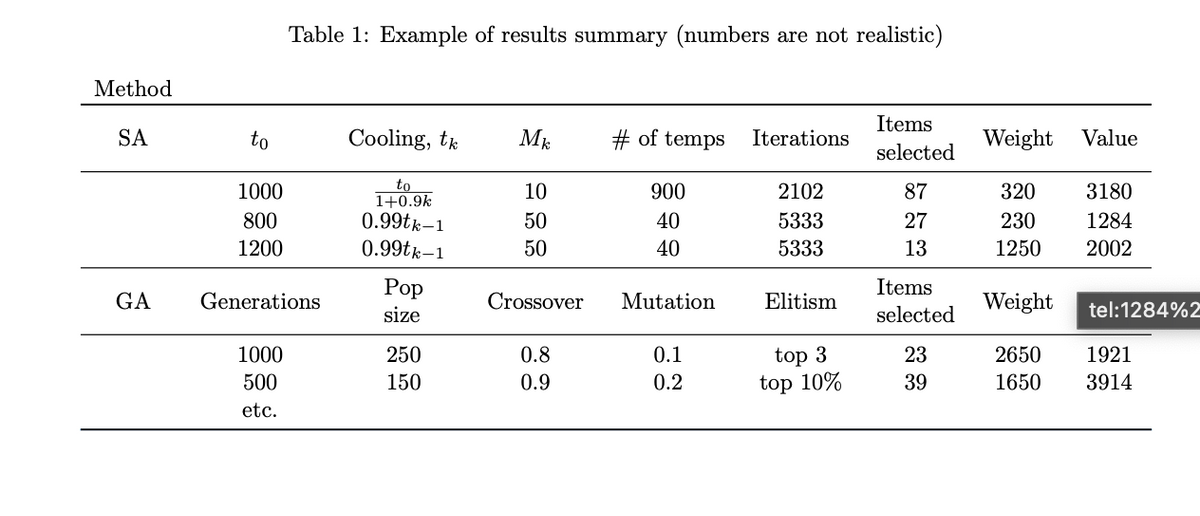Using the provided Python code from the previous homework as a base, implement Simulated Annealing in code. Please address the following by including the associated Python code excerpts (as appropriate) and explanation of the code in the PDF file: • Logic to determine the initial temperature • At least two different temperature cooling schedules (the temperature update procedure) and ex- plore some options for the number of iterations performed at a given temperature (Mk) • Python logic excerpt for computing the probabilities of accepting a non-improving move Stopping criterion • Apply the code to the random problem instance and determine the best solution and objective value using the multiple variations of your algorithm (e.g., different cooling schedules, different starting temperatures, different values for Mk). Method Table 1: Example of results summary (numbers are not realistic) SA to Cooling, tk Mk # of temps Iterations Items selected Weight Value to 1000 10 900 2102 87 320 3180 1+0.9k 800 0.99tk-1 50 40 5333 27 230 1284 1200 0.99tk-1 50 40 5333 13 1250 2002 Pop Items GA Generations Crossover Mutation Elitism Weight size selected tel:1284%2 1000 250 0.8 0.1 top 3 23 2650 1921 500 150 0.9 0.2 top 10% 39 1650 3914 etc.
Using the provided Python code from the previous homework as a base, implement Simulated Annealing in code. Please address the following by including the associated Python code excerpts (as appropriate) and explanation of the code in the PDF file: • Logic to determine the initial temperature • At least two different temperature cooling schedules (the temperature update procedure) and ex- plore some options for the number of iterations performed at a given temperature (Mk) • Python logic excerpt for computing the probabilities of accepting a non-improving move Stopping criterion • Apply the code to the random problem instance and determine the best solution and objective value using the multiple variations of your algorithm (e.g., different cooling schedules, different starting temperatures, different values for Mk). Method Table 1: Example of results summary (numbers are not realistic) SA to Cooling, tk Mk # of temps Iterations Items selected Weight Value to 1000 10 900 2102 87 320 3180 1+0.9k 800 0.99tk-1 50 40 5333 27 230 1284 1200 0.99tk-1 50 40 5333 13 1250 2002 Pop Items GA Generations Crossover Mutation Elitism Weight size selected tel:1284%2 1000 250 0.8 0.1 top 3 23 2650 1921 500 150 0.9 0.2 top 10% 39 1650 3914 etc.
Computer Networking: A Top-Down Approach (7th Edition)
7th Edition
ISBN:9780133594140
Author:James Kurose, Keith Ross
Publisher:James Kurose, Keith Ross
Chapter1: Computer Networks And The Internet
Section: Chapter Questions
Problem R1RQ: What is the difference between a host and an end system? List several different types of end...
Related questions
Question

Transcribed Image Text:Using the provided Python code from the previous homework as a base, implement Simulated Annealing
in code. Please address the following by including the associated Python code excerpts (as appropriate)
and explanation of the code in the PDF file:
• Logic to determine the initial temperature
• At least two different temperature cooling schedules (the temperature update procedure) and ex-
plore some options for the number of iterations performed at a given temperature (Mk)
• Python logic excerpt for computing the probabilities of accepting a non-improving move
Stopping criterion
•
Apply the code to the random problem instance and determine the best solution and objective value using
the multiple variations of your algorithm (e.g., different cooling schedules, different starting temperatures,
different values for Mk).

Transcribed Image Text:Method
Table 1: Example of results summary (numbers are not realistic)
SA
to
Cooling, tk
Mk
# of temps
Iterations
Items
selected
Weight Value
to
1000
10
900
2102
87
320
3180
1+0.9k
800
0.99tk-1
50
40
5333
27
230
1284
1200
0.99tk-1
50
40
5333
13
1250
2002
Pop
Items
GA
Generations
Crossover
Mutation
Elitism
Weight
size
selected
tel:1284%2
1000
250
0.8
0.1
top 3
23
2650
1921
500
150
0.9
0.2
top 10%
39
1650
3914
etc.
Expert Solution
This question has been solved!
Explore an expertly crafted, step-by-step solution for a thorough understanding of key concepts.
This is a popular solution!
Trending now
This is a popular solution!
Step by step
Solved in 2 steps

Recommended textbooks for you

Computer Networking: A Top-Down Approach (7th Edi…
Computer Engineering
ISBN:
9780133594140
Author:
James Kurose, Keith Ross
Publisher:
PEARSON

Computer Organization and Design MIPS Edition, Fi…
Computer Engineering
ISBN:
9780124077263
Author:
David A. Patterson, John L. Hennessy
Publisher:
Elsevier Science

Network+ Guide to Networks (MindTap Course List)
Computer Engineering
ISBN:
9781337569330
Author:
Jill West, Tamara Dean, Jean Andrews
Publisher:
Cengage Learning

Computer Networking: A Top-Down Approach (7th Edi…
Computer Engineering
ISBN:
9780133594140
Author:
James Kurose, Keith Ross
Publisher:
PEARSON

Computer Organization and Design MIPS Edition, Fi…
Computer Engineering
ISBN:
9780124077263
Author:
David A. Patterson, John L. Hennessy
Publisher:
Elsevier Science

Network+ Guide to Networks (MindTap Course List)
Computer Engineering
ISBN:
9781337569330
Author:
Jill West, Tamara Dean, Jean Andrews
Publisher:
Cengage Learning

Concepts of Database Management
Computer Engineering
ISBN:
9781337093422
Author:
Joy L. Starks, Philip J. Pratt, Mary Z. Last
Publisher:
Cengage Learning

Prelude to Programming
Computer Engineering
ISBN:
9780133750423
Author:
VENIT, Stewart
Publisher:
Pearson Education

Sc Business Data Communications and Networking, T…
Computer Engineering
ISBN:
9781119368830
Author:
FITZGERALD
Publisher:
WILEY